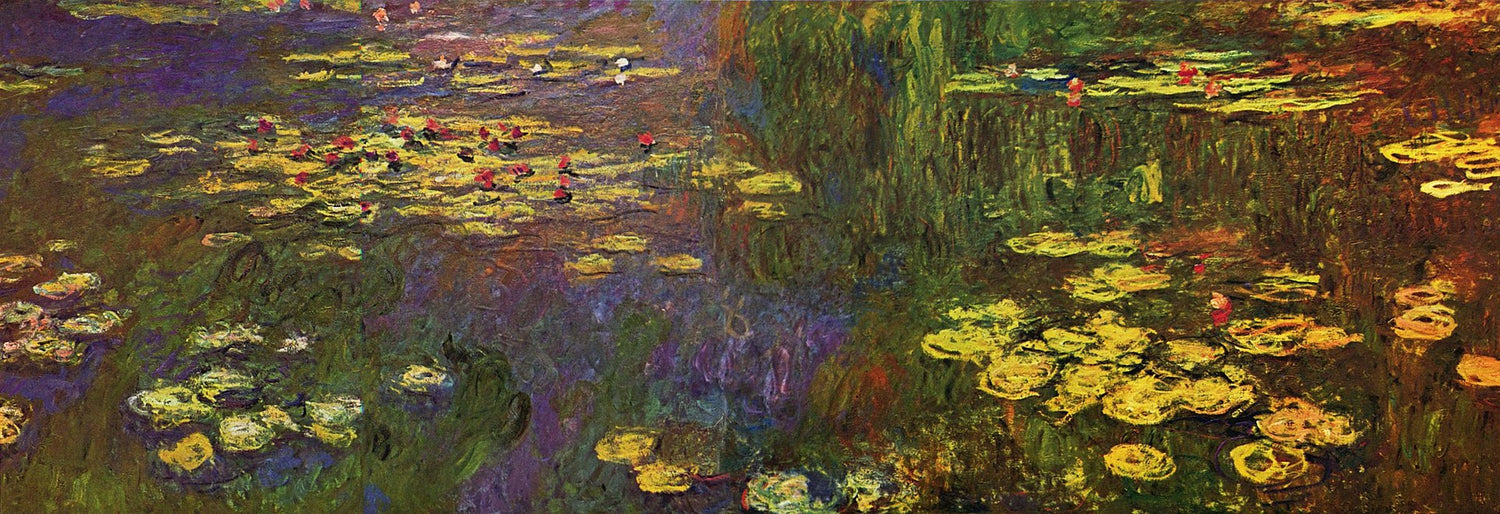Claude Monet, often regarded as the father of impressionnism, is an artist who left a profound mark on the history of art. Born in Paris in 1840 and raised in Le Havre, his passion for painting was evident from an early age. Monet, with his avant-garde vision, sought to capture the essence of landscapes and moments, focusing on nuances of light and colour. Instead of following the rigid academic conventions of his time, he adopted a freer approach, using rapid brushstrokes and bold compositions to capture the immediacy of a scene. This quest for the ephemeral moment led him to create series of paintings, in which the same subject is depicted in different lighting or at different times of day. Among these series, the >Water Lilies hold a special place, not only in his work, but also in the hearts of art lovers the world over.
The inspiration behind the water lilies
Monet's Water Lilies, a series of 250 paintings, are not the result of chance, but rather the culmination of deep introspection and meticulous observation of nature. The artist, always seeking to capture the essence of landscapes, was particularly moved by the beauty of ponds and water flowers. The changing reflections, the nuances of light at different times of the day, and the tranquillity of the waters deeply inspired him. These elements gave Monet a living canvas, a painting in perpetual evolution, where light, colour and texture mingle in a harmonious dance. The Water Lilies thus became an obsession for him, a never-ending quest to capture the elusive, to paint not a simple representation of nature, but rather his feelings and emotions in the face of this ephemeral beauty.

The garden at Giverny
The garden at Giverny was much more than just a garden for Claude Monet; it was his sanctuary, his open-air studio. Acquired in 1883, this little corner of paradise in Normandy quickly became the artist's main source of inspiration. With a precise vision in mind, Monet meticulously landscaped the garden, creating a pond adorned with water lilies, weeping willows and small bridges. Each element, each plant, has been carefully chosen and placed to create a living tableau. It was in this idyllic setting that Monet spent hours painting, capturing the reflections of the water, the shadows of the trees and the changing light. The garden at Giverny was not only a place of residence for Monet, but also a creative space, where every nook and cranny, every flower, every reflection became an inexhaustible source of inspiration for his works.
The characteristics of water lilies
The evolution of the series
Monet's Water Lilies did not remain static. Over the years, the series evolved, reflecting changes in the artist's vision and state of mind. The early works were more detailed, with clear depictions of flowers and reflections. Over time, the paintings became blurrier, more abstract, emphasising atmosphere rather than precise detail. This transition to abstraction shows Monet's desire to transcend simple representation to touch the very essence of nature.
The techniques used
Monet adopted innovative techniques to bring his Water Lilies to life. Using quick, light brushstrokes, he was able to capture the immediacy of a scene. Rather than simply painting what he saw, he sought to capture what he felt. This emotional approach, combined with his bold use of colour, gave his paintings a unique dynamic and depth.
Light and colour
Light and colour are at the heart of the Water Lilies. Monet was fascinated by the way light changed throughout the day, influencing colours and shadows. Rather than settling for a fixed palette, he chose a variety of hues to depict the same scenes at different times. Blues, pinks, greens and yellows merge, creating a visual harmony that evokes the ephemeral beauty of nature.
The perception of nature
For Monet, nature was not simply a subject to be painted; it was a living entity, changing and mysterious. In his Water Lilies, he did not seek to reproduce a faithful image, but to convey a sensation, an emotion. Each painting is an invitation to see nature not simply as a landscape, but as a sensory experience, where sight, touch and even sound combine to create a symphony of sensations.
The impact of water lilies on modern art
Monet's Water Lilies had a profound influence on modern art. By breaking with academic conventions and exploring new techniques and approaches, Monet paved the way for abstraction and expressionnism. His paintings, with their bold interplay of light and colour, challenged traditional perceptions of art and inspired many twentieth-century artists. The Water Lilies are more than just a series of paintings; they represent a revolution, a transition to a new era in which emotion takes precedence over exact representation.
Concluding remarks
Claude Monet's Water Lilies are not just works of art; they are the testimony of a passion, a relentless quest for beauty and emotion. Through this series, Monet invites us to see the world differently, to appreciate nuances, reflections and fleeting moments. More than a century after their creation, these paintings continue to fascinate, touch and inspire, proving that true art transcends time and borders.












